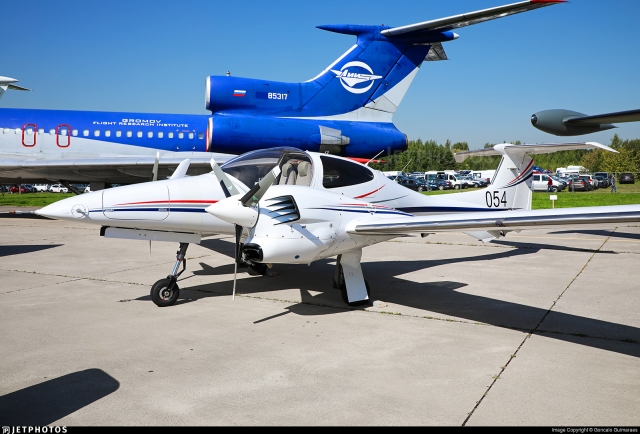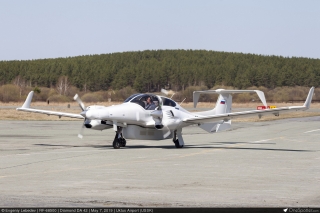 Diamond DA42 – the little known asset of the Russian Armed Forces
Diamond DA42 – the little known asset of the Russian Armed Forces
Back in 2016, a short notice appeared on the Zakupki public procurement website about an impeding purchase of two Diamond DA42M-NG Twin Star light twin-engine surveillance aircraft for the Russian FSB (Federal Security Service). Given the relatively modest price the sale went almost completely unnoticed. Now, after a few years, we come back to report about the fate of the DA42 aircraft in service with Russia.
The story of using the DA42 as trainers with the Russian Ministry of Defence dates back to 2010-2011 where the requirements for a specialized training version of the DA42 NG, designated DA42T, were written down. Few years later, in 2013, the UZGA (JSC Ural Civil Aviation Plant) factory in Yekaterinburg received a contract from the Ministry of Defence for arranging series assembly of single-engined Diamond DA40s and twin-engined Diamond DA42s, alongside the venerable L-410UVP light haulers once developed by the Czechoslovak company LET Kunovice. The reported order for the Diamond DA42Ts was 35 aircraft in total.
It took the company another few years to achieve the required 100% level of localization of parts and the first three fully locally assembled aircraft (serials 051, 052, 053) were finally delivered in December 2017, with 17 followed in 2018 and 15 in 2019. The DA42Ts, and also the single-engined DA40s, went to the Saint Petersburg State University of Civil Aviation located at the campus in Aviagorodok (Aviation town) next to Pulkovo Airport.
Further DA42Ts were delivered to Balashov Aviation Training Centre of the Krasnodar Higher Military Aviation Pilot School (KVVAUL) and are used for training cadets of Russian military transport aviation before they move on to mult-engine aircraft like the An-26 transporter. Due to political sensitivity the aircraft are rarely photographed, the only noted numbers in St.Petersburg are 004, 051, 052, 053 and 054 and in Balashov 02, 06 and 019 Black, with some additional noted construction numbers from photos from the factory in 2019; 42.TR009, 42.TR010 and 42.TR012.
Now, back to the mentioned surveillance version. This one is most likely based on Diamond’s own DA42N Guardian type. An aircraft of this version, coded 402 Black (reported c/n 25402, Russian name Ratnik), has been spotted at the UZGA factory back in 2014, albeit with mock-up of the opto-electronic equipment installed at that time. This aircraft is most probably only used for demonstration purposes. The final version for the FSB, for which two aircraft are known at this moment, was developed by a company RTI AKS (RTI Aerospace Systems) which added a digital aerial surveillance complex, and a broadband and satellite communication line, thus forming an airborne segment of an integrated monitoring system allowing real-time high resolution monitoring of ground and air objects around the clock in all weather conditions. Each of the two aircraft has different onboard equipment – the 421 Black is focused on the optoelectronic sensors, carrying a multifunctional FLIR ball under its nose while the 422 Black carries a BLRK airborne radar electronic complex in a semi-recessed pod under the fuselage. These aircraft are aimed at demonstration of the interaction between the particular components of the entire system via satellite communication channels, as well as assessment of the technical capabilities of the sensors. It is likely that in the future this surveillance system will be used with the unmanned version currently designated as DA42B.
 The two already delivered DA42M-NGs went to a Federal State Institution called Military Unit 55056, which, according to open sources, relates to the Department of Material and Technical Support of the FSB of Russia. The maximum price of the contract is was set at RUB 758,28 million (USD 10,2 million in FY 2016) and the delivery was to be completed by 25 November 2017.
The two already delivered DA42M-NGs went to a Federal State Institution called Military Unit 55056, which, according to open sources, relates to the Department of Material and Technical Support of the FSB of Russia. The maximum price of the contract is was set at RUB 758,28 million (USD 10,2 million in FY 2016) and the delivery was to be completed by 25 November 2017.
Just like the DA42T trainers, the DA42M-NG is also equipped with AE300-E4 series aircraft diesel engines manufactured by Austro Engine which can run on a classic Jet A-1 fuel. All aircraft are sporting the Garmin G1000 glass cockpit consisting of two 12in LCD display panels (Primary Flight Display and Multifunction-Display), GMA Audio Panel, GMC Remote Controller and GRS77 Attitude and Heading Reference System (AHRS).
Photos: Goncalo Guimaraes, kindly provided by Jetphotos.com and Evgeniy Lebedev, kindly provided by OneSpotter.com

